International Journal of Engineering and Manufacturing @ijem
Статьи журнала - International Journal of Engineering and Manufacturing
Все статьи: 550
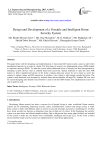
Design and Development of a Versatile and Intelligent Home Security System
Статья научная
This paper deals with the designing and implementation of microcontroller based security system to alert when unauthorized persons try to enter in a home. The first phase of security was implemented using a GSM module to send alert message (SMS). To make the system robust additional layers of security has been incorporated by including security devices such as android based door password, manual keyboard to open the door, PIR motion to detect unauthorized person in the home, rotating ultrasonic sensor by servo motor to active the camera to capture image and RF transceiver to produce voice signal to alert people outside the home. The system's main hardware was designed by Arduino based microcontroller ATmega328. Arduino ISP was used for system designing and Arduino serial monitor is used to test the GSM module. The implemented system was seen to perform well.
Бесплатно

Design and Implementation of Cost Efficient SCADA System for Industrial Automation
Статья научная
Supervisory Control and Data Acquisition system facilitates the monitoring and control of industrial process from the designated control station. The cost investment for implementing the SCADA system is expensive and is not in approach of small and medium scale industries these days. Developing the customized SCADA system helps to reduce the cost in software components and becomes more close approach to the small and medium scale industries. In this research we presented a SCADA software developed in C# environment and successfully tested in industrial process monitoring and control. The developed SCADA software is capable of remotely supervise, control and data monitoring facility and is also capable of data logging in the IoT server. This approach has been found to be efficient in both aspects, technically and economically.
Бесплатно
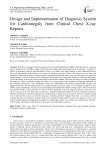
Design and Implementation of Diagnosis System for Cardiomegaly from Clinical Chest X-ray Reports
Статья научная
With the increasingly broadening adoption of Electronic Health Record (EHR) worldwide, there is a growing need to widen the use of EHR to support clinical decision making and research particularly in radiology. A number of studies on generation, analysis and presentation of chest x-ray reports from digital images to detect abnormalities have been well documented in the literature but studies on automatic analysis of chest x-ray reports have not been well represented. Interestingly, there is a large amount of unstructured electronic chest x-ray notes that need to be organized and processed in such a way that it can be automated for the purpose of giving urgent attention to abnormal radiographs in clinical findings to allow for quicker report analysis and decision making. This study developed a system to automate this analysis in order to prioritize findings from chest x-rays using support vector machine and Lagrange Multiplier for the constraint optimization. The classification model was implemented using Python programming language and Django framework. The developed system was evaluated based on precision, recall, f1-score, negative predictive value (NPV). Expert’s knowledge was also used as gold standard and comparison with the existing system. The result showed a precision of 96.04%, recall of 95.10%, f1-score of 95.57%, specificity of 86.21%, negative predictive value of 83.33% and an accuracy of 93.13%. The study revealed that a limited but important number of relevant attributes provided an effective and efficient model for the detection of cardiomegaly in clinical chest x-ray reports. From the evaluation result, it is evident that this system can help the clinicians to quickly prioritize findings from chest x-ray reports, thereby reducing the delay in attending to patients. Hence, the developed system could be used for the analysis of chest x-ray reports with the purpose of diagnosing the patient for cardiomegaly. Chest X-ray reports are usually textual, therefore, further studies can introduce spell checker to the system to provide higher sensitivity.
Бесплатно
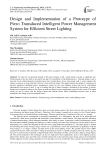
Статья научная
To meet the ever-growing demand of this power hungry world, wasted energy can play a significant role. Wasted energy is the one which is not used in any part of a transferred or transformed process. Footstep energy is such a type that can be utilized properly in potential areas like crowded places. Every time people walk, a system captures this energy as pressure or stress and then converts it into electrical energy. This paper presents the design of a prototype of pressure transduced intelligent power management system for the street lighting system that can be self-enabled automatically from dawn to dusk. A way of avoiding the risk of battery damage is introduced in this design. A priority based power connection scheme is also shown to make an effective power management system for this system. The output results are also in accord with the design scheme that indicate almost linear relationships between stress in piezo transducers and voltage or power produced from it.
Бесплатно
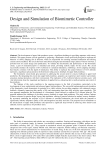
Design and Simulation of Biomimetic Controller
Статья научная
The development of upper limb prostheses poses a significant challenge in providing amputees with sensory feedback. This paper presents a novel approach by proposing a biomimetic circuit specifically designed to replicate the behavior of slowly adapting (SA-I) afferents, which are responsible for encoding sustained indentation and offering crucial sensory feedback. The circuit has been meticulously designed and simulated using Cadence Virtuoso software, a powerful tool for circuit design and optimization. To validate the functionality and performance of the biomimetic circuit, a grid of mechanoreceptors is simulated and tested, providing realistic inputs for the circuit. The circuit successfully emulates the response of SA-I afferents to sustained indentation, exhibiting a slowly adapting discharge that linearly correlates with the depth of indentation. This ability to replicate the natural behavior of SA-I afferents represents a significant advancement in the field of providing sensory feedback for upper limb prostheses. The biomimetic circuit holds great promise in addressing the crucial need for sensory feedback in upper limb prosthetics. By integrating this circuit into upper limb prostheses, amputees can experience more intuitive and realistic sensations during interactions with their environment. The replication of SA-I afferent behavior provides users with vital information about the magnitude and duration of applied forces, enhancing their overall perception and control of the prosthesis. The findings of this study contribute to the ongoing progress in the field of prosthetics, particularly in the development of more sophisticated and advanced upper limb prostheses. The successful implementation and simulation of the biomimetic circuit demonstrate its potential as a viable solution for providing amputees with enhanced sensory feedback, ultimately improving their quality of life and reintegrating them into daily activities more seamlessly. The new approach emphasizes the development of a biomimetic circuit tailored to replicate SA-I afferent behavior. The proposal addresses the challenge of providing sensory feedback in upper limb prostheses. The study utilizes Cadence Virtuoso software for precise design, layout, and simulation, offering a practical solution for realistic sensory feedback. By accurately emulating the response of SA-I afferents to sustained indentation, the circuit holds the potential to significantly enhance amputees' quality of life and integration into daily activities. The proposed circuit contributes to the advancement of upper limb prosthetics and represents a significant leap forward in achieving more intuitive and authentic sensory experiences for prosthesis users.
Бесплатно
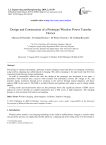
Design and construction of a prototype wireless power transfer device
Статья научная
This project is aimed at developing a prototype wireless charging system that allows for charging convenience using wireless charging also called inductive charging. This allows charging to be made easier and free from connecting leads between charger and handset. In order to successfully achieve this task, the design of the prototype was developed in two parts, a transmitter with resonator and a receiver with resonator. The transmitter converts DC voltage to AC, and transfers energy wirelessly through an LC resonator to the receiver through mutual induction, and hence induces EMF in the receiver. The EMF is rectified, filtered and regulated and output is used to charge mobile phones. Testing results and measurements taken on this prototype shows that significant amount of EMF can be induced at receiver through air coupled transformers due to EM waves at high frequencies. The charging distance is 3cm maximum with end-to-end coupling.
Бесплатно

Design and construction of an obstacle-detecting glasses for the visually impaired
Статья научная
This paper introduces a wearable eyeglass with an ultrasonic sensor to help the blind to navigate alone safely, while avoiding obstacles that may be encountered, fixed or mobile, thereby preventing any possible accident. The main component of this work is the ultrasonic sensor, which is used to measure the distance to an object using sound waves. By recording the elapsed time between the wave being generated and the wave bouncing back, it is possible to calculate the distance between the sensor and the object. A limitation of the project is that even though it can operate alone as an independent device, its full functionality to be achieved, it needs to be part of a whole system hence making it an auxiliary device. An integration of this device with a smart walking stick or an automatic wheelchair can help realize its full potential and make it the ultimate mobility aid. This system is cheap, fast and easy to use and it is an innovation for the blind and visually impaired people to help them overcome the various problems in their daily life.
Бесплатно
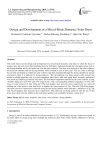
Design and development of a mixed-mode domestic solar dryer
Статья научная
This work focuses on the design and development of a mixed-mode domestic solar dryer in which the slices of pepper, okra and yam were dried simultaneously by both direct radiation through the transparent glass roof of the drying chamber and by the heated air from the solar collector. The dryer was made up of the solar collector, the desiccant chamber and the drying chamber which contains a rack of three trays. The air comes in through the air inlet and heated up within the solar collector and then channeled through the drying chamber by natural convection where it is utilized for drying purposes. The development was done using locally sourced and readily available materials such as wood, transparent glass sheet, mild steel metal sheet, mosquito galvanized wire mesh and chicken galvanized wire mesh. The maximum temperature attained by the solar collector, drying chamber during test were 69oC and 55oC respectively, with a corresponding ambient temperature of 39oC. The mass of water removal of 43g, 136g and 255g from pepper, okra and yam slices respectively was achieved making use of the passive solar food dryer as against the water removal of 39g, 126g and 218g from pepper, okra and yam slices respectively achieved using the sun drying method which indicates a difference of 4g, 10g and 37g for pepper, okra and yam slices respectively. The rapid rate of drying achieved with the use of this dryer shows that it has the ability to dry food items rapidly to an acceptable moisture content level.
Бесплатно
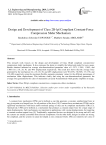
Design and development of class 2B-lpl compliant constant-force compression slider mechanism
Статья научная
This research work focuses on the design and development of Class 2B-lpl compliant constant-force compression slider mechanism. It also expresses the desire to simplify the behavioral model for easy usage. Results obtained indicated an average non-dimesionalized parameter value of 1.2573, 1.2991, 1.3483, and 1.4081 for a 10, 20, 30, and 40% displacement respectively. The result also shows that the average force generated by the mechanism for a 10, 20, 30, and 40% displacement were 901.23N, 316.56N, 171.17N, and 110.44N respectively using the maximum flexible segments parameter values for the different percentages of mechanism slider displacement. This indicates clearly that using the non-dimensionalized parameter, the average force generated by this class of mechanism can easily be determined which greatly simplifies its usage.
Бесплатно
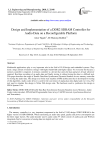
Design and implementation of a DDR2 SDRAM controller for audio data on a reconfigurable platform
Статья научная
Multimedia applications play a very important role in the field of VLSI design and embedded systems. They need a large amount of memory storage with higher bandwidth and higher speed. To overcome this hazard, a memory controller is required. A memory controller is a device that stores the data and gives it back whenever required. Real-time recording of an audio data and finally storing it without losing the data is a difficult task. This paper describes the usage of Double Data Rate Synchronous Dynamic Random Access memory controller for storing the audio data. The design uses finite state machine (FSM) architecture that is developed for testing of this algorithm. Audio codec device is used for the conversion of analog data into digital and vice versa. The tool used to simulate this design is Xilinx ISE design suite. The hardware used to synthesize this design is FPGA Spartan-3 kit.
Бесплатно
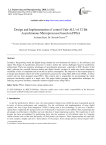
Design and implementation of control Unit-ALU of 32 bit asynchronous microprocessor based on FPGA
Статья научная
In today’s fast growing world, the digital design domain has two dominant role factors i.e. the efficiency and speed. The design of asynchronous processor is used to reduce the various challenges faced in synchronous architectures. There are numerous advantages of asynchronous processors, especially in SOC (System on the chip), reducing the crosstalk between analog and digital circuits, easiness in multi-rate circuit integration, reusability of ease of component and at last the less power consumption. The objective of this research paper is to design and simulate control unit of the asynchronous processor by using Xilinx ISE tool in VHDL. A robust control unit has been designed using FPGA. This control unit is responsible for accumulating the whole processor functioning control at a single unit. This paper further presents the optimization techniques for reducing area power and delay constraints related to digital circuits using FPGA.
Бесплатно
Design and implementation of solar tracker to defeat energy crisis in Pakistan
Статья научная
Proposed Solar tracker minimizing the angle of incidence and solar panel position towards the sun to achieve the maximum solar irradiation and strength so that it can produced the maximum output (electricity).
Бесплатно
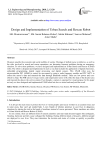
Design and implementation of urban search and rescue robot
Статья научная
Disasters unsettle the economic and social stability of society. Shortage of skilled rescue workforces, as well as the risks involved in search and rescue operations, are becoming foremost problems during an emergency situation. To solve these problems, we have designed and implemented an Urban Search and Rescue (USAR) robot. The robot is designed and implemented in such a way that includes the application of digital electronics, embedded programming, digital signal processing and digital sensors. This USAR robot uses the microcontroller PIC 16F690 to control its movement by using a radio frequency module and PIC 16F73 to collect the sensor’s data and transmit the data through Bluetooth module. These are low power and cost-effective chips. The PIR sensor, Co2 gas sensor, and temperature sensor will collect the data of the disaster area and transmit the data to the service station. Even though, a camera is operated for visual purpose. In this paper not only we have designed and implemented USAR robot but also we tested and analyzed the result.
Бесплатно
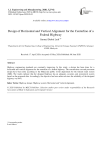
Design of Horizontal and Vertical Alignment for the Centerline of a Federal Highway
Статья научная
Highway engineering standards are constantly improving. In this study, a design has been done for a horizontal and vertical alignment for the centerline of a federal highway. The construction cost and pavement design have been done according to the Malaysian public works department for the federal roads system (JKR). The results indicate that the designed highway has an adequate, accurate, and economical system based on the proposed data. Accordingly, the objective has been achieved since the reliability of the designed highway was 94%.
Бесплатно
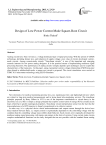
Design of Low Power Current Mode Square-Root Circuit
Статья научная
Analog circuits have been viewed as a voltage dominated type of signal processing. With the advent of CMOS technology, shrinking feature size, and reduction of supply voltage a new class of circuits developed: current-mode circuits. Among current-mode circuits "Translinear circuits" is one of the important and emerging research interests for low power analog designers. It is the practical means of implementing nonlinear signal processing functions. The performance of analog circuits strongly depends upon techniques used to exploit the characteristics of the transistors. In this paper, using exponential current-voltage relationship of MOS transistor when biased in subthreshold-mode, a square-root circuit is proposed. The circuit simulations were carried on TSMC 0.18 micrometer technology using ELDO Simulator.
Бесплатно
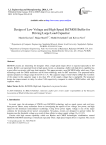
Design of Low Voltage and High-Speed BiCMOS Buffer for Driving Large Load Capacitor
Статья научная
BICMOS circuits are interesting for designers when a high speed output driver is required especially in I/O circuits. Buffer is an important block in high speed circuits, so designing a buffer with high drive capability has a great effect on circuits with large load capacitor. This paper presents a new BiCMOS buffer which uses 32nm technology node for CMOS transistors and 0.18um technology node for BJT transistors. The proposed buffer operates properly in voltage ranges from 0.8v to 1.5v. The capacitor range is from 0.5pf to 200pf; the overshoot of the output in this capacitor range is less than 10% of the supply voltage that is negligible. The proposed design has improvements in delay for about %88 respectively compared to similar CMOS buffers with high capacitor values.
Бесплатно
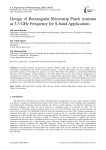
Design of Rectangular Microstrip Patch Antenna at 3.3 GHz Frequency for S-band Applications
Статья научная
Low-profile antennas are required for aircraft, satellites, radar, and a variety of other vehicles due to aerodynamic considerations. The "patch" or microstrip antenna is a narrow band antenna with a low profile and low gain. Patch antennas are becoming more popular as a result of their ability to be printed on a circuit board. Microstrip antennas can be rectangular, circular, elliptical, or any other regular form, but the most common configurations are rectangular and circular. This research constructed a rectangular patch antenna that operates in the 3.3 GHz (S-band) operating frequency based on a description of microstrip antenna working principles. Agilent ADS Momentum software is used to create and simulate the antenna model. Finally, by optimizing and matching to meets, the best performance parameters such as Gain, Directivity, Efficiency, Power Intensity, Radiated power, and Return loss are obtained.
Бесплатно
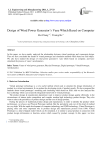
Design of Wind Power Generator’s Vane Which Based on Computer
Статья научная
In this paper, we have mainly analyzed the relationship between virtual prototype and concurrent design. Then we have concluded the model of virtual prototype and simulation method which based on field object. We also have studied the design of wind power generator’s vane which based on computer, and have simulated the process of vanes’ aerodynamics.
Бесплатно
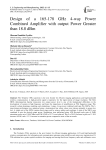
Design of a 165-178 GHz 4-way Power Combined Amplifier with output Power Greater than 18.8 dBm
Статья научная
The Terahertz (THz) spectrum is the next frontier for efficient imaging applications and high-bandwidth wireless communication. A high-powered signal is imperative for the improvement of image resolution. The SiGe HBTs (heterojunction bipolar transistors) low output power level is one of the fundamental difficulties in the development of systems at high frequency and hence the importance of amplification at THz frequency range. This research is about designing, modeling, and simulating a 3-stage, 4-way power combined solid state PA (SSPA). The 3-stage design performance was optimized using a transmission line whose values were chosen optimally to ensure low loss. A single unit of the SSPA contains three stages and by using a splitter and combiner, 4 units of the SSPA were combined to give the desired output power. Simulations were performed using ADS Keysight and a gain of 30dB, saturation power out of 18.847dBm, and PAE (PAE) of 5.7% was achieved. This is a 28.8% increase in gain, an 11.36% increase in PAE, and a 3.3 % increase in saturation power compared to state-of-the-art results.
Бесплатно
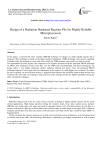
Design of a Radiation Hardened Register File for Highly Reliable Microprocessors
Статья научная
In this paper, a powerful bit upset masking (PBUM) technique for design of a high reliable register file is proposed. This technique is based on the triple modular redundancy (TMR) technique with the key capability of double faulty bit masking in every triad of bits while the TMR structure, only masks one fault in a triad. We implemented a 64-bit register file comprised of 64 registers protected with the proposed PBUM technique on FPGA. Our simulation results reveal that, over the TMR and some Hamming code-based techniques, our design offers a very higher robustness against radiation induced soft errors. Also, the proposed PBUM technique imposes a lower delay than its counterparts at the expense of a little higher area overhead. To reduce the area overhead, an area-efficient strategy is suggested that balances the reliability improvement and the area overhead. We show that, our technique using this area-aware strategy still has the highest reliability among the other considered techniques.
Бесплатно

